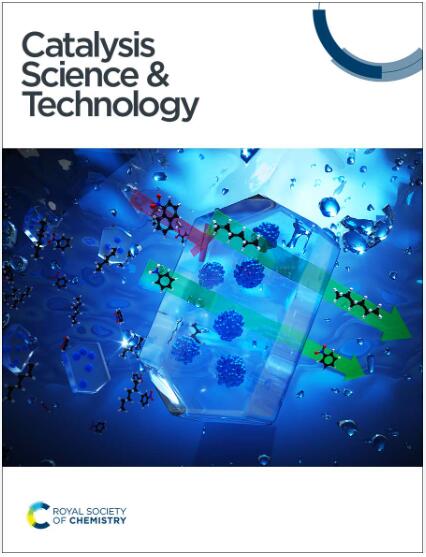Direct C–N coupling of aniline to aminodiphenylamines with a platinum-loaded titanium oxide photocatalyst†
IF 4.4
3区 化学
Q2 CHEMISTRY, PHYSICAL
引用次数: 0
Abstract
Aminodiphenylamines (ADPAs) and their derivatives have been known to be used as dye intermediates and antioxidants of rubber. Due to their high demand in industrial production, their synthesis methods have been widely developed. In the present study, a photocatalytic asymmetric homocoupling route was examined, i.e., the photocatalytic C–N coupling of aniline in an alkaline solution with a Pt-loaded titanium oxide (Pt/TiO2) photocatalyst. A nearly 20% yield and 77% selectivity were achieved with the Pt/TiO2 photocatalyst for 30 min. It was found that this C–N bond formation showed a high dependence on the pH of the solvent and irradiation light wavelength, i.e., the reaction can only proceed when pH > 11.79, and an incident light wavelength of 365 nm gave a high ADPA selectivity. The mechanistic studies by using isotopic compounds suggested that the rate-determining step (RDS) for ADPA production would be the formation of a transition complex with rehybridization to sp3 on the aromatic ring of aniline. The UV-vis spectral analysis and Arrhenius plots further revealed the presence of three formation routes of ADPAs in the present system: the first one begins with the hole-oxidation of aniline by the TiO2 photocatalyst excited by UV light, the second one starts with one electron transfer from the N atom in aniline to Ti in TiO2, which only occurred with an incident light wavelength of 365 nm, and the last one is the oxidation of aniline molecules by hydroxyl radicals as a minor route.

用负载铂的氧化钛光催化剂直接C-N偶联苯胺与氨基二苯胺†
众所周知,氨基二苯胺(ADPA)及其衍生物可用作染料中间体和橡胶防老剂。由于其在工业生产中的高需求量,其合成方法已被广泛开发。本研究考察了一种光催化不对称均偶联路线,即在碱性溶液中用铂负载氧化钛(Pt/TiO2)光催化剂光催化苯胺的 C-N 偶联。在 30 分钟内,Pt/TiO2 光催化剂实现了近 20% 的产率和 77% 的选择性。研究发现,C-N 键的形成与溶剂的 pH 值和照射光的波长有很大关系,即只有当 pH 值为 11.79 时,反应才能进行,而入射光波长为 365 nm 时,ADPA 的选择性较高。利用同位素化合物进行的机理研究表明,ADPA 生成的速率决定步骤(RDS)是苯胺芳环上的 sp3 再杂化形成过渡复合物。紫外-可见光谱分析和阿伦尼乌斯图进一步揭示了本系统中 ADPA 的三种形成途径:第一种途径始于 TiO2 光催化剂在紫外光激发下对苯胺的空穴氧化;第二种途径始于苯胺中 N 原子向 TiO2 中 Ti 原子的一次电子转移,这种转移只发生在入射光波长为 365 纳米时;最后一种途径是苯胺分子被羟基自由基氧化,这是一种次要途径。
本文章由计算机程序翻译,如有差异,请以英文原文为准。
求助全文
约1分钟内获得全文
求助全文
来源期刊

Catalysis Science & Technology
CHEMISTRY, PHYSICAL-
CiteScore
8.70
自引率
6.00%
发文量
587
审稿时长
1.5 months
期刊介绍:
A multidisciplinary journal focusing on cutting edge research across all fundamental science and technological aspects of catalysis.
Editor-in-chief: Bert Weckhuysen
Impact factor: 5.0
Time to first decision (peer reviewed only): 31 days
 求助内容:
求助内容: 应助结果提醒方式:
应助结果提醒方式:


